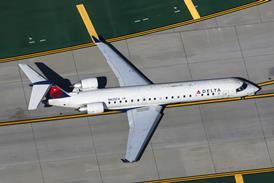Andrew Doyle/LONDON
THE TWO MANUFACTURERS which will offer engines for Boeing's 747-500X/600X derivatives laid their cards on the table at Farnborough, and highlighted the radical differences between two powerplants which could end up being remarkably similar in terms of performance.
General Electric and Pratt & Whitney chose Farnborough to reveal details of their joint venture, christened GE-P&W Engine Alliance, which will develop the GP7000 family of engines, starting with the 338kN (76,000lb)-thrust GP7176. Rolls-Royce, as had been widely expected, launched its Trent 900 derivative engine at an initial thrust rating of 356kN.
Developments have moved quickly in this sector of the engine market. Boeing started the year expecting to use off-the-shelf Airbus A330-sized powerplants for its 747 derivatives, so minimising development costs and risk. Studies began to show that the aircraft would be unlikely to meet Stage 3 noise limits, offer adequate reductions in direct operating costs and offer enough growth potential without the development of new powerplants.
A short, but hectic, period of behind-the-scenes talks, resulted in R-R deciding to "go it alone", with a derated version of the Trent 800, while GE and P&W, keen to avoid a repeat of the ultra-competitive engine contests, which have dogged all three manufacturers on the Boeing 777, decided to form a joint venture.
GE-P&W Engine Alliance claimed at Farnborough that "-both companies believe that a derivative engine will not fully meet the fuel burn, operating economics, noise and payload/range requirements of the 747 growth aircraft".
The GP7000, which is expected to cost $1 billion to develop, will give GE another application for the expensive high-pressure system technology it developed for the GE90, which has effectively become a single-application powerplant on the 777. P&W is left with responsibility for the low-pressure system, along with final assembly and testing.
Programme sources say that neither partner will be able to "share" expertise on each other's section, with each retaining responsibility for the design, development, certification, manufacture and service support of their own section.
The Trent 900, meanwhile, will comprise a 90% "scaled" Trent 800 core, and will retain the existing 2.8m-fan, accessories and dressings of R-R's 777 powerplant. The company claims that the Trent's three-shaft design will give it an inherent weight advantage over the two-shaft GP7000 of 2,270kg per aircraft.
R-R was also keen to promote the "derivative" status of the Trent 900, although it is not yet clear whether this will result in significantly lower development costs. The company has indicated only that development costs are likely to be "less than $1 billion".
Some industry insiders claim, however, that bearing in mind GE-P&W's plans to use low-risk GE90 and PW4000 technology for the GP7000, R-R could effectively be undertaking an equivalent amount of development work on the Trent 900.
Manufacturers' claims aside, the airlines that have received initial briefings on the engines believe that their performances are likely to be similar. A glance at the list of potential launch customers for the 747-500X/600X, however, suggests that R-R is well placed to win most of the early orders.
Source: Flight International























